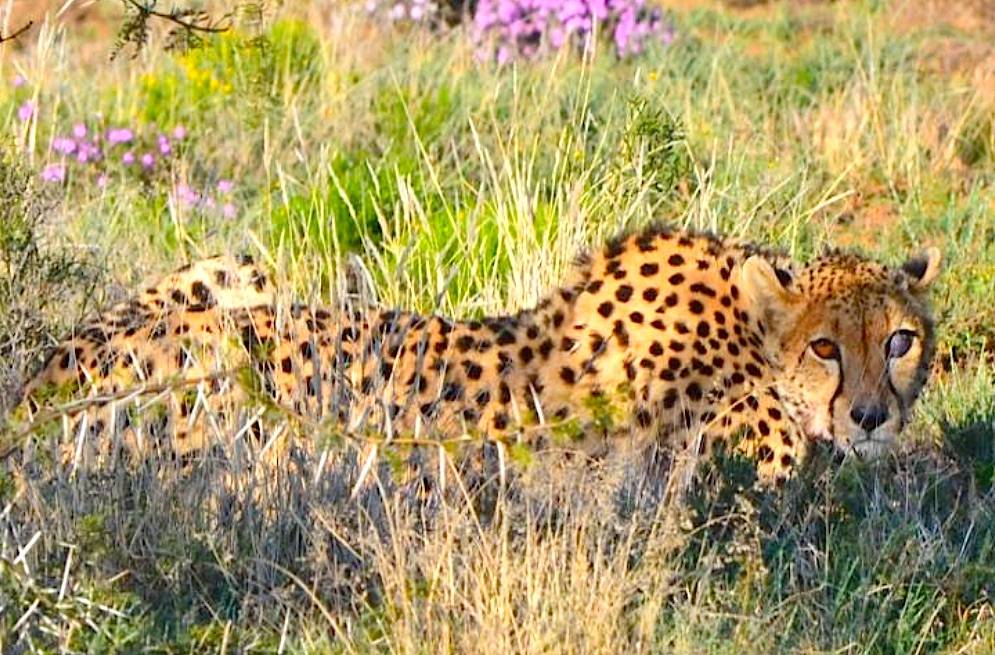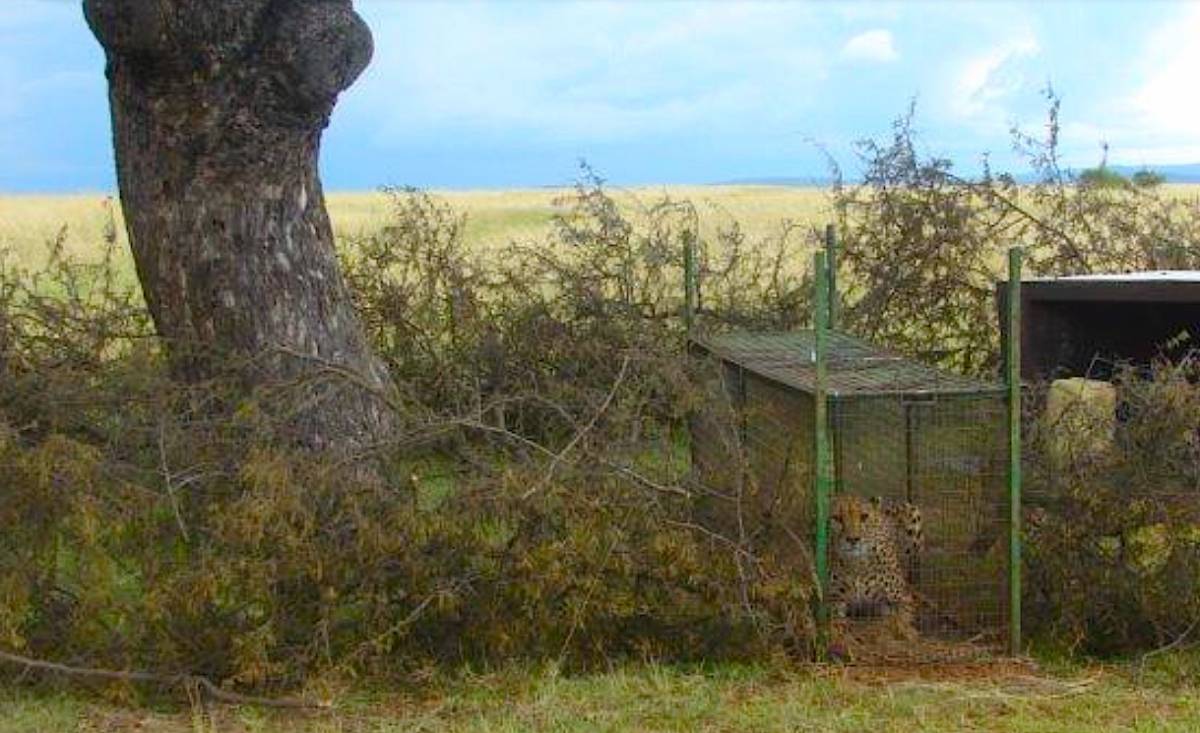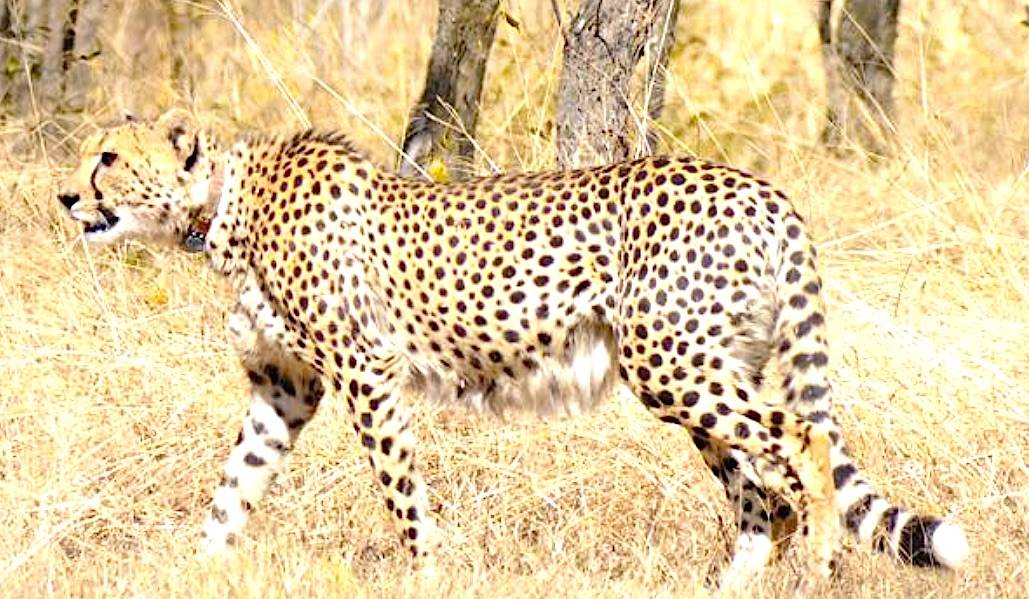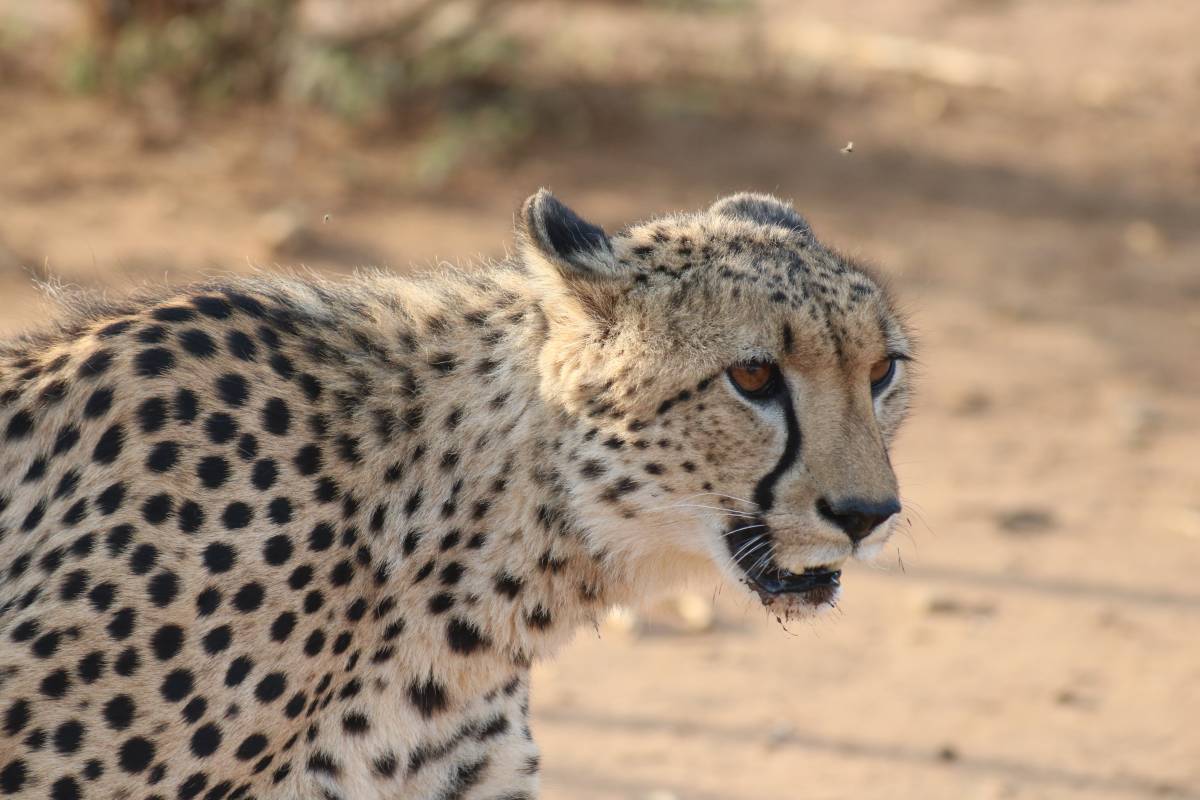Blog
The secret of cheetah number 4B626D7E5B
It sounds like an unreal Christmas tale. But it is a true story. What is the secret of Cheetah number 4B626D7E5B? And what has this mysterious cat to do with Madikwe?
And here is where the story begins. It was in September 2011 when the Endangered Wildlife Trust of South Africa (EWT) receives a call from Addo Elephant National Park. A Cheetah of unknown origin is moving right through the park and into a farming area just north of the reserve. This Cheetah proceeds to kill 34 goats in the Darlington area and is finally caught by a farmer in a gin trap. Fortunately the Cheetah sustains minor wounds from this nasty device. No free roaming Cheetah has been reported in the Eastern Cape since 1888. The origin of this male is a complete mystery.
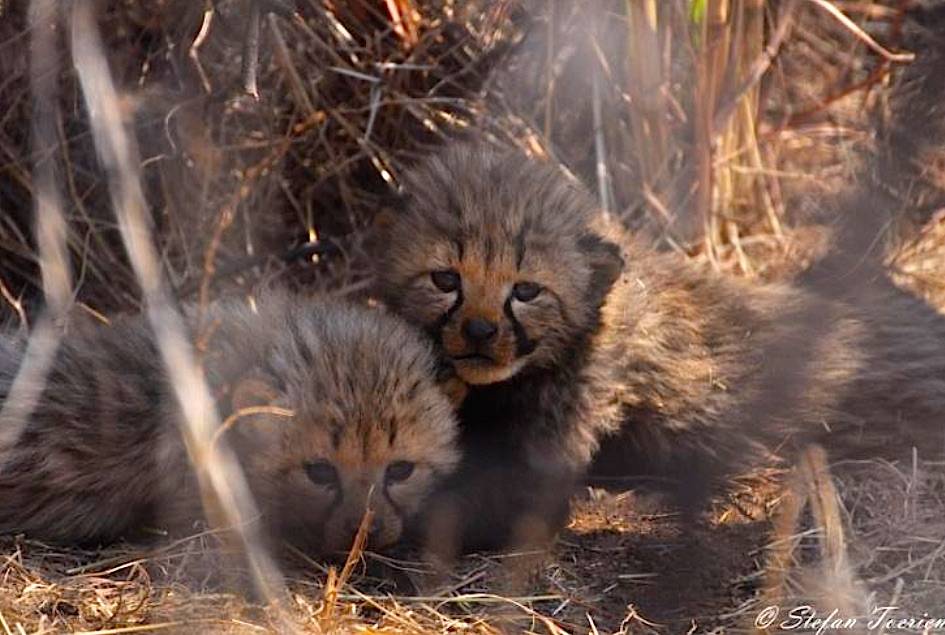
Four young cubs, fathered by the Darlington male, were born on Dinokeng Private Game Reserve in August 2013.
Addo management makes it clear that this male does not belong to them. Luckily, the newly dubbed “Darlington male” finds a new home in Monate Private Reserve in Limpopo. But the Darlington male has other plans. After spending just one week in the fully electrified Monate boma a ‘Warthog’ hole appears. Cheetah spoor emerge from this hole. But where is Darlington male? Despite Monate being fully stocked with a wide variety of suitable prey species, he is seen wandering about on neighbouring cattle farms, running down Blesbok into the fencelines of the numerous cattle camps. His preference for heavily fenced areas with low densities of game is perplexing.
A concerted effort is made to catch this elusive male. Specially trained sniffer dogs are brought in. Cage traps are set up in numerous locations. It slowly appears that this Cheetah is a fence specialist, an escape artist of formidable calibre. It is going to take a special game capturer to return this animal to the reserve. After running about on neighbouring farms for three months the Darlington male is finally captured in cage trap specially constructed around a large Marula tree.
Before any further plans are made the Darlington male is collared so that he can be tracked should he once again escape. Whilst he is being collared, the veterinarian’s scanner bleeps. The mysterious Cheetah has a chip implanted on the back of his neck. The Chip has a number: 4B626D7E5B. The results column indicates one match. Is this the answer to the riddle?
Number 4B626D7E5B comes from a place called “Gondwana”. There are nine Cheetah reserves in close vicinity to the Darlington area and Gondwana is certainly not one of them. The two areas are 480 kilometres apart as the crow flies. There are large mountain ranges, numerous commercial farms and road networks between Gondwana and Darlington. Thus, the Darlington male has walked across perhaps 150 commercial farms from the period October 2010 to September 2011. He had a remarkable ability to move through fencing and could adapt easily to living in an array of habitats.
It must have been an extraordinary journey. We will never know which route he took. No reports of a free roaming Cheetah were received during that period. It is however likely that he avoided heavily forested areas and the more developed Garden Route coastline. All along the way he would most likely have survived by feeding on domestic animals. Goats and sheep would have been fairly plentiful in these areas. The deaths of domestic animals could’ve been blamed on Leopard which do occur at low densities in these areas.
Slowly the entire story about Cheetah number 4B626D7E5B begins to unravel. In October 2006, the Darlington male is born in the Samara Private Game Reserve, where Cheetah are known to compete for higher lying grassland areas where it frequently snows in winter. He is one of two male cubs from his mother Ariaan who had no vision in her left eye, leaving it with a characteristic cloudy appearance.
The two youngsters break away from Ariaan at 17 months of age. The formidable pair are quick to realise that the prime hunting grounds on Samara are the high altitude grasslands where they will find large herds of Springbok, Blesbok, Eland, Kudu, Black Wildebeest, Mountain Zebra and Hartebees. The only problem, however, is that this area is occupied by their father. Mosart is reportedly a large and formidable male. He has presided over the prime Cheetah habitat on Samara for many years. One day, the young Darlington male and his brother stumble across their father. A fearsome brawl breaks out. Outnumbered two to one by his own offspring, Mosart stands little chance and gets killed.
Unimpressed by the behaviour of the young coalition, Samara reserve management decides that these skittish young cheetah with little tourism potential have to go. These single males, like Mosart, are well habituated to humans and provide good game viewing for visiting tourists. Fortunately, in September 2010, Gondwana, a new big five reserve near Mossel Bay, is willing to take in the young coalition, and they keep them for three months in a boma to habituate the skittish Cheetah to humans. Darlington male gets a chip with the number 4B626D7E5B.
This move is a terrifying experience for the young coalition. Darted and shoved into a tiny transport crate, driven for seven hours and dumped into a boma in a completely unfamiliar environment. And the worst is still to come. Gondwana has recently acquired a pride of Lion. Quick to sniff out new predators, these lions are certain to visit the novice Cheetah on the night of their arrival.
The young coalition have never encountered Lion before and it is a frightening experience and the Darlington male is quick to realise that these Lion meant business. On the very first night of his arrival he escapes from his fully electrified boma. Reserve management is shocked when they arrive at the boma the next morning. Lion spoor marked the outskirts of this small fenced area and only one cheetah remains.
In the corner of the boma there appears what seems to be a warthog hole, carefully excavated under the fence. This hole is however the work of the Darlington male. Cheetah spoor emerge from the hole, trotting over the Lion spoor and into the greater reserve. Reserve management is quick to react. The remaining male is rapidly collared and released in the hope that he will hook up with his fleeting brother.
This tactic works and one week later the two males are seen together for the first time. The Lion pride, however, has unfinished business with the young Cheetah coalition. Three days after being observed together, the brother of the Darlington male is found dead. His neck is broken, his skull crushed and large claw marks are observed on his body and collar.
This event obviously has a marked effect the Darlington male and he has no plans to stick around. He is quick to find a spot on the reserve that is free of Lion. A small herd of wildebeest roams a 60ha private housing estate that is fenced to keep predators and other dangerous game out. The Darlington male utilises his newly acquired fence hopping skills and breaks into this estate. He is spotted by residents and reserve management races in to dart him. The plan is to have him collared immediately and put him back into the boma. The boma period would neutralise his homing instinct and ensure that he becomes more habituated for game viewing. Management arrives too late and he can not be immobilised. He is last seen at Gondwana on a Cape Grysbok kill in October 2010. He is presumed dead, probably killed by Lion as was the case with his brother. But then, 11 months later, an unknown Cheetah crosses Addo reserve.
And so, the origin of the Darlington male is finally established. It is decided that Dinokeng Private Game Reserve will be the most suitable release site for the Darlington male. Dinokeng is Gauteng’s first big five reserve. It is very well fenced due to its proximity to densely populated human settlements. A female is also sourced for Dinokeng as her presence could prevent him from once again escaping reserve boundaries.
The Darlington male is moved from Monate to Dinokeng in September 2012. Living up to his reputation he immediately escapes from his boma. Within two days of his escape he kills an adult Blesbok and a young Blue Wildebeest. The Darlington male has lived and travelled in four of South Africa’s provinces. There is concern that he wants to see the remaining five. It is hoped that he will finally settle and spend the rest of his days at Dinokeng, contributing some of his fine genetics to the South African Cheetah Metapopulation. By August 2013 the Darlington male has escaped twice from Dinokeng Private Game Reserve. On each occasion he is located through his satellite collar, darted via helicopter and returned to the reserve.
In September 2013 the Darlington male fathers four young cubs. His legacy lives on. Shortly after fathering this litter he is killed in unfortunate circumstances after he escapes from the reserve for the 7th time. Fortunately his genetics have been preserved in his offspring who continue to contribute to Cheetah conservation efforts in South Africa.
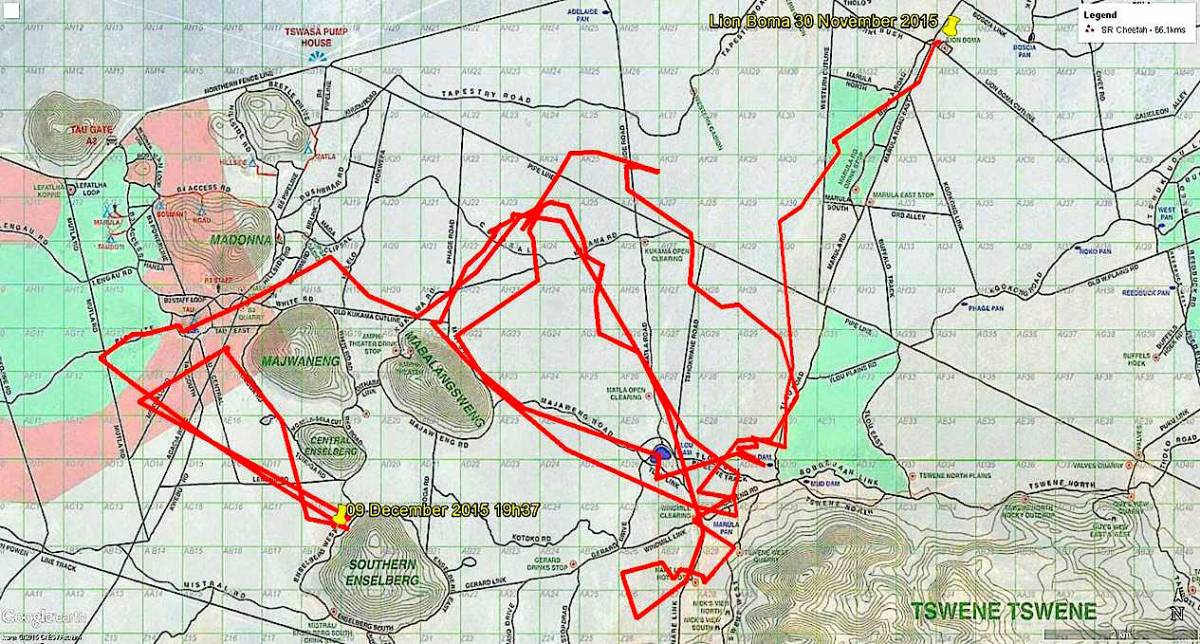
Information from the satellite collar indicate that the two boys covered 66.1km within the first week in Madikwe.
And here is where the story ends ... and where another exciting story is about to begin. One month ago, in November 2015, two male Cheetah are released into Madikwe Reserve. As first results from close monitoring show, the newcomers are doing very well, are quite relaxed and seen occasionally on game drives.
Declan Hofmeyr, Environmental Management Inspector, who follows the movements of the two Cheetah, says: “They’ve found water, encountered lions, white rhino and black rhino. They’ve tried to hunt impala and steenbok so they’re well on their way to total independence.” There are indications that the brothers are successfully hunting and get their feed themselves. Hofmeyr: “I dropped an impala for them recently and they showed no interest. However we have no evidence yet of this so we’ll keep monitoring them and help them along if need be.”
Information from the satellite collar indicate that the two boys covered 66.1km within the first week in Madikwe. They are very independend and long distance walkers. That's no surprise when you know the story of their father, the famous "Darlington male".
